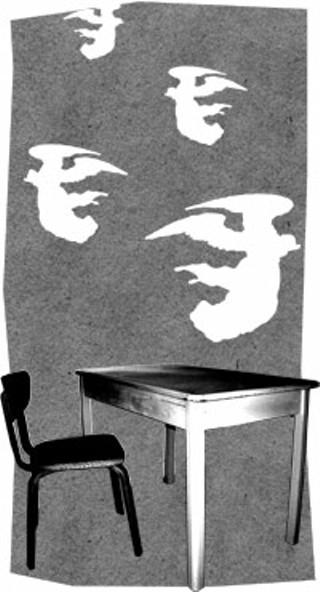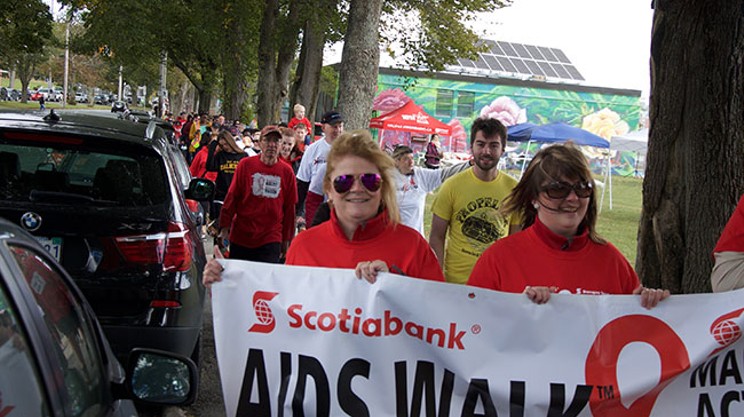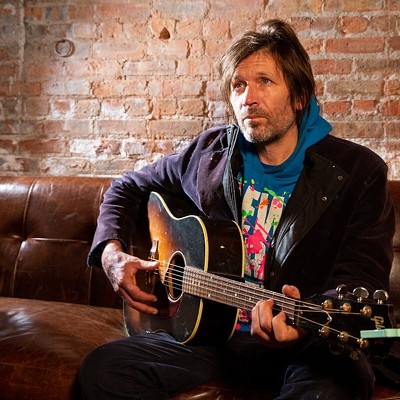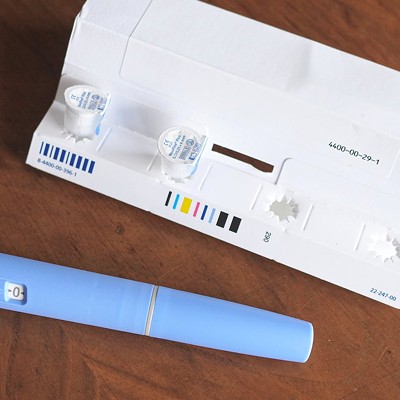There’s this pamphlet. It’s called HIV and Mental Health. And there are two happy white people on the inside back cover riding a red tandem bicycle. They’re coasting along a sunny downtown street. And they are smiling; they are glowing, like they’re in an ad for milk or toothpaste. The woman, on the back of the two-person bike, has her legs out straight in front of her and she’s smiling right at the camera. It’s like her whole body—her whole being—is saying Wheeeeeeee!
She doesn’t look like Pam Leedham.
And it’s not because she’s smiling and Leedham’s not (and she doesn’t once, for the whole time I’m sitting with her at her two-person kitchen table in a housing co-op in north Dartmouth). And it’s not because these people are like two cut-outs from a Dockers ad and it’s autumn and Leedham is tanned the colour of an avocado pit (“seems like no one tans anymore,” she shrugs) and she’s dressed in cut-offs and a garish bright tank top. And it’s not because the bike riders are probably in their 30s but look like they’re 20 and Leedham is 42 but her face shows 55.
Pam Leedham doesn’t look like the HIV and Mental Health bike-riding couple because those two are together. They may be models, a clipart symbol of happiness and hope, but they’re selling something else by default. Love. Coupledom. At least companionship.
And Pam Leedham is alone.
Well, I’m there. But I don’t count. Because it took a long time to find her, several tries to get in touch with her, and one missed meeting she forgot about to finally hook up. I tried to reach her again a few times after we spent an afternoon together, but she didn’t call back and didn’t answer the door and I wonder if I’ll ever see her again. Maybe she was too busy to call back. Or maybe she just wants it that way. Like she says, “Right now…I’m just focusing on me. I’ve never done that before in my life.”
Sitting in her small eat-in kitchen, Leedham’s story spills out like cake batter into a baking pan. It comes in a thick, slow unrelenting mass. She’s talking, talking, talking. Talking non-stop. Are you hearing rapid fire bursts when I describe it that way? Because that’s not what Pam Leedham is like. No. Her words are measured. Not pensive, but drained of the dips and peaks of emotion.
You have to listen closely.
But the story of Pam Leedham—and, no, that’s not her real name—isn’t easy to hear. By part, it’s the story of how she became addicted to drugs. The story of how she has lost everybody who loved her. The story of how she contracted HIV. And the story of how she’s collecting loose hairs between her nicotine-stained fingers in a serious bid to re-braid her life.
Pam Leedham’s good with her hands. Her front door’s open when I arrive at her ground floor bachelor apartment.
Hello?
She’s sitting on the edge of a living room chair cutting Raphaelite angels out of dollar-store wallpaper border. She says “hicomeinI’mjustcuttin’outtheseangels” with scarcely a glance up from the scissors. Once she makes the last snip she takes me directly into the bathroom to show how she’s pasting them to the wall above the toilet and sink. Next to the kitchen. The same cut-out angels keep watch from the wall above the stove.
Is it a good place to sit to do this interview?
Yup. Yup.
The place is surprisingly lived-in, given Leedham’s been there just one month and had only a bed, the chair and her TV when she arrived on the doorstep. Her kitchen’s got everything it needs. The place is fully stocked with knick-knacks already. “It’s homey; I like it this way,” she says. Someone was going to give her a couch too. “I don’t have company over,” she says, “so what the hell do I need a couch for?”
I have time to get a good look at Leedham’s kitchen supplies and ceramic bears because the 42-year-old doesn’t make eye contact once during the first 10 minutes we’re officially talking. She’s belly up to the kitchen table working intently at rolling a cigarette. We are an absurd-looking pair, like performers in the starting position for a modern dance piece. I’m sitting, facing her. My knees are an inch from her thigh. But I’m talking to her left ear. And she’s talking to the tobacco she’s crumbing onto the table with her forefinger, middle finger and thumb. She tears down six or seven inch-long butts—rip, pick, pick, pick. Rip, pick, pick, pick—and slides the pile of tobacco onto a Zig-Zag. Rolls it. Lights it. Smokes it. Looks at me.
And I think, OK, now she can better concentrate on the conversation and maybe she won’t repeat herself so much. But she does. She says it’s short-term memory loss.
Devastated. Devastated. Devastated.
That’s the word she repeats the most.
And she is devastated. Has been devastated. Knows devastation. But every time she talks about the wreckage and desolation and the unluckiness Pam Leedham has faced in her life, she counters it with an affirmation. (“I know in my heart I’m a good person and a caring person. I am a recovering drug addict and I will be until the day I die. But that doesn’t make me a bad person. I’m a good person.”) And it makes me think all the stories about injecting drugs and losing friends and family and contracting HIV aren’t Pam Leedham’s story at all. Pam Leedham’s story is only starting now.
She calls it a year, but it was 10 months ago Pam Leedham was diagnosed with HIV.
She had just made a big decision. She had decided to begin—for the second time in her life—the gruelling process of getting off drugs.
“I couldn’t get out of bed in the morning without a fix,” she says. “I couldn’t function. I couldn’t do anything without the Dilaudid.”
That was the physical reality of her addiction to Dilaudid (a synthetic pain reliever with effects similar to morphine which she would buy in pill form, then crush, cook and inject). The theoretical what-it-comes-down-to moment for Leedham was this: “I never did acid or any hallucinogens growing up. I always wanted to be in control of the high. And I think that’s what it come down to with the Dilaudid. The Dilaudid had control over me.”
She admitted herself to the detox program at Simpson Hall, located at the Nova Scotia Hospital on Pleasant Street in Dartmouth. Later she began a methadone treatment program though Gottingen Street’s Direction 180.
All good. Then she got sick. But more than that, Leedham says, she had a sick feeling.
“I got pneumonia and I knew it wasn’t withdrawal sickness. I knew it was worse.”
HIV-positive, they said.
“I thought, what’s the point of trying to stop drugs and clean up my life now? Because it’s all over.”
She figured she might as well just kill herself. She kept going to Direction 180 instead.
The distance between those choices is a seldom-travelled route. And how Pam Leedham got from point A—doing herself in—to point B—committing to the difficult work of a daily methadone program to wean off drugs and the equalled effort of beginning Highly Active Anti-Retroviral Therapy for HIV—is a fuzzy trip. Even she can’t quite explain what got her off drugs, on HIV meds and methadone and into the orderly knick-knack-proud home she’s in today. She just says, “I always had for a kick in the ass.
“When I need them, they’re there. The days that I wasn’t feeling good, they could tell. And I would say, I don’t want to do this anymore. I’m tired. I’d be almost in tears. But now I haven’t had one of them days in a really long time. In four or five months.
“180,” she says, “they became my family and my friends.”
She’s not joking.
“All my life, pretty much, I had a drug problem,” Leedham says.
And while that’s a vague description, it’s perhaps the most apt, because it’s difficult for Leedham to keep it all straight. Best she can figure, it pieces together something like this:
Leedham was drinking alcohol and smoking pot and hash from the age of 12. Later in her teens, her mother (who still lives in Saint John, New Brunswick, where the family grew up) used to ship all the kids off to summer camp from June through September. Leedham hated it. When she came home to visit she would steal her dad’s nerve pills, Benzodiazepines. Benzos, she calls them. They’re anti-depressents.
“When I was 16,” Leedham says, “I convinced a doctor that I needed them and he wrote me a prescription from the time I was 16 until I was 30.”
Leedham says, “I liked the nerve pills. I never did hard drugs.”
But when she was 28, Leedham’s husband was lost in a boating accident. No euphemism there—he went out boating and literally disappeared. It took 10 months to find his body.
“I hit the cocaine pretty hard,” she says. “I was tired and someone gave it to me, said, ‘It’ll keep you going.’”
Two years later, at age 30, Leedham figured enough was enough and admitted herself into detox in Saint John.
The hard part wasn’t the cocaine, it was getting off the Benzos. “It was hell.”
She met a man after her 28 days as a detox in-patient and fell in love. He had been working in Saint John and was moving back to Halifax. He asked her to come with him. At some point in there—between the end of cocaine and Benzo detox and coming to Nova Scotia for her sweetheart, she also fell in love with Dilaudid.
“I thought,” Leedham says, “if I move, I’ll get away from the Dilaudid. But it was just as bad…I knew more drug dealers down here than I knew in Saint John. I ended up knowing a doctor who would give me my prescription.”
Leedham kept on keepin’ on—living in Halifax and shooting Dilaudid—for the better part of a decade. When she was 39, her partner (by then her fiancée) went into a diabetic coma. He died.
Soon after, she found out she had Hepatitis C, a serious viral infection that can cause cirrhosis of the liver and liver cancer.
“All the years I did needles,” she says, “I never shared needles. I always thought I’ll never catch anything because I always use a clean needle.”
That’s a good rule but it’s only half the message. If you’re trying to avoid viruses from a high-risk activity like injecting drugs, you’re not supposed to share any part of your kit. Viruses can be transmitted through needles, yes, but also straws, pipes, spoons and other equipment.
“I must have got , and the Hep C, through a filter or a spoon,” Leedham says. “I wouldn’t touch a spoon if had blood on it but . I didn’t know you could get it that way, or I wouldn’t have done it.”
And surely she wouldn’t have done it if she knew that one member of the group of friends she used to shoot up knew she was HIV-positive. “She gave it to me and three other girls. She’s out west and she’s never coming back.”
Leedham hasn’t told any friends she’s HIV-positive. And even if she wanted to, she couldn’t. Now that she’s clean, they’re gone. “All my friends are users. I don’t buy them drugs anymore so they’re never around,” she says between hauls off her cigarette. She hasn’t told any of her new neighbours in the housing co-op, either. She’s friendly there, but keeps mostly to herself.
She’s been warned away from disclosing her positive status by the reactions of some she’s told, like her social worker. She says he treats her differently now that he knows she’s HIV-positive. “Just his attitude,” she says.
“I lost my bus pass. And he said I’m not issuing you another bus pass, you’re going to have to deal with it…. I said I’ve been getting a bus pass for four years now. I’ve never lost a bus pass before.
“He never treated me like that before he found out I was HIV-positive.”
She says it, but she says it like it doesn’t bother her much. The slight—or at least her re-telling of it—rolls off her like the smoke that’s curling up through her brassy blond hair. Her social worker isn’t someone Leedham expects a lot of compassion from anyway.
Her family? That’s different.
Leedham’s family members are the only other people—besides a few health care professionals—Pam Leedham has told that she’s HIV-positive.
She had hoped it would go better.
“My mum, she looks after two handicapped kids,” Leedham says, “and it’s like, ‘We can’t have it here. What if you infect the kids?’ it’s like the ’80s when nobody knew nothin’ about it.
“My dad passed away four years ago,” she says. “The rest of my family don’t want nothin’ to do with me. Basically they just said, you got yourself into it by doing drugs, you’re going to have to deal with it. It’s your problem.”
There’s one family member Leedham hasn’t let in on the secret.
Her son.
He’s 24 and lives in Saint John and she “loves him right to death” and she talks to him on the phone from time to time. But she hasn’t told him.
She’s part interested in sparing him the grief—-“If I got really really sick and they said I only had three or six months to live, then I would sit down and talk to him. But right now I just don’t want to put that burden on him.” And she’s part interested in sparing herself the grief of him possibly reacting the way her mother and siblings have.
So she’s alone. She goes to get her methadone every morning on the bus, is diligent about her doctors’ appointments and gets support from the AIDS Coalition of Nova Scotia.
And later, she comes home and cuts out angels and rolls smokes and fixes up her place and watches TV and listens to the radio. And she’s healthy. Even with HIV. Even with Hepatitis C. Even though she’s had two stents put in her heart this year. She’s the healthiest she’s been in ages. Perhaps since she was a kid.
After close to one year on HIV meds, her immune system is holding and her viral load is undetectable. (That’s when the virus still there, but it’s being kept in check. It’s a best-case scenario.)
And it’s making her experience something she has yearned for for a long time.
“I feel very much in control,” she says.
“I want to live a healthy life. I’m only 42. I want to live to be 80.”
She probably won’t.
No one’s sure exactly how long people with HIV and AIDS can live. There is a small group of people in Nova Scotia who are going on 20 years with the disease. There are a handful in the world who have known they were positive since the early ’80s. But no one’s really sure how long people with HIV and AIDS can live. The newest class of HIV drugs—-called protease inhibitors—-were only introduced in 1996. Ten years isn’t long enough to tell how they’ll affect patient longevity or, importantly, quality of life.
Pam Leedham is undaunted.
“I think maybe before another 20 years is up, they’ll have a cure,” Leedham says. “I was talking to a nurse last week and she was saying that she the first case of HIV back in the ‘80s and it was back in the Infirmary. They had the person isolated and they didn’t know if they were going to burn the mattress. It’s come so far in 20 years.”
Still, she admits, “I don’t know that a cure would change my life a whole lot.”
Leedham sounds like one of those easy-going lottery winners who’s going to keep trucking to the fish plant every weekday until retirement even through she’s got a cool four million Super7 bucks in the bank.
But it’s not that Leedham would choose her lot. It’s that she doesn’t have much choice anyway.
Pam Leedham is poor. And that affects her life more right now than being HIV-positive.
No one who goes to the Infectious Diseases clinic at the Queen Elizabeth II Health Sciences Centre (where most HIV-positive Nova Scotians are treated) pays for services (that can run anywhere from $1,000 to $3,000 per month for medications alone). If a patient’s extended medical coverage won’t take care of the cost, the province will.
People with HIV and AIDS can also receive extra support from the AIDS Coalition of Nova Scotia: access to a professional hair stylist and massage therapist once a month. And there’s the AIDS Coalition Health Fund—-$75 every two weeks for people who live below the Statistics Canada-determined poverty line. The money can offset costs such as the ID clinic pharmacy’s dispensing fee, which is about $10 per visit, and other medications patients might need, like drugs for nausea.
For the rest, people fend for themselves. And being poor only makes it harder.
With or without HIV, many of Pam Leedham’s health issues would be the same. Because many of the things that contribute to good health as a person with HIV or AIDS are the same things that contribute to good health as an HIV-negative person—-proper nutrition, access to non-prescription drugs, lower stress levels, exercise, adequate personal support. All challenges for people living poor.
So, a cure for HIV? While life-changing, it wouldn’t necessarily change Pam Leedham’s life. “It would be nice,” she says.
Really, she’s making all the changes by herself right now.
“I’ve been thinking about going back to school and taking a counsellor’s course,” she says. “I want to see if I can get into the schools to talk to kids in grades seven, eight and nine and high schools and tell them my story.
“For the longest time I never thought I could speak out in public about my disease, but I almost want to be heard.”
Almost. But for now, she still doesn’t want me to use her real name.
“There are days still when I feel really depressed,” she says. “But I made a decision: do I want to live? Or do I want to die? I made the decision that I wanted to live. I want to fight this. I don’t want to give in to it.”
In other words, Pam Leedham is making up her story as she goes along.
HIV didn’t put Pam Leedham on social assistance. HIV didn’t buy her hash at age 12. HIV didn’t get her into a methadone program. HIV didn’t affect her short-term memory. HIV didn’t get her this sunny bachelor apartment.
HIV does not define her.
And neither does being poor.
Drug recovery does not define her. Being abandoned by her family does not define her.
What does? Pam Leedham does. Starting now.
Editor’s note
This is the third and final part in Lezlie Lowe’s series about locals living with HIV/AIDS. There are several ways to pigeonhole the HIV-positive, and Lowe began her reporting with subjects who fit some of the common archetypes: October 12, she profiled a heterosexual woman infected by her husband, she wrote about a gay man last week and here is profiling an intravenous drug user. But she also went looking for the real people behind the tidy categories, and found lives that can be messy and complicated and difficult and wonderful. Just like yours.
Lezlie Lowe is a freelance writer living in Halifax.




















